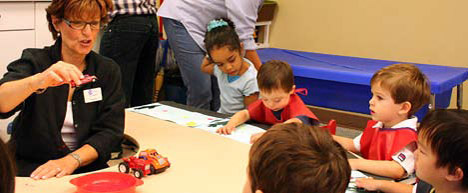
Have you ever noticed how some young children just do not seem to know how to listen to others?
When someone is talking to them, a child may not stop playing in order to look up and acknowledge the other person. He might start listening, but soon get bored and change the subject or simply turn away.
Like other social skills, the skill of “active listening” is one that some children have to be taught – step by step.
Helping your Child Become a Good Listener
As a parent, teacher or early childhood professional, you care teach your child to be a good listener using these ideas.
- Talk about it
Start by talking to your child about this specific skill. Ask him questions like:- “How can you be a good listener?”
- “What does a good/not a good listener do?”
- “How does it feel when you are talking to someone, and they are/aren’t listening to you?”
- Teach
Teach your child a rule that will help him understand and use the skill. A Social Script can be helpful at this stage. It is a way of teaching children how to behave in specific social situations. It might include suggestions of specific things your child can say or do in response to the social situation.Note: Depending on your child’s skill level, you can write a Social Script using words only, or you can add pictures or photographs to help describe each step.
Here is an example of a Social Script written to help a child learn how to “listen to others”.

Review and practice the script at least once a day with your child, especially when you first introduce it. As your child begins to understand and use the new skill, you can practice the script less often and refer back to it to remind him what to do in specific situations. It is not a good idea to try using the Social Script while the situation is happening. Instead, review it at the beginning of the day and then, when the situation actually occurs, you can remind your child of what he has learned.
- Role play
Role-playing consists of acting out various social interactions that children would typically encounter. Puppets or other toys can also be used as “actors” in the role-play. Role playing teaches children the actual words they can say and the things they can do in specific situations. It also gives children an opportunity to practice these new skills with their peers.In the beginning, you should play all the ‘parts’ to show your child what he can do or say in certain situations. You can keep him interested by using characters from his favourite television shows. Be sure to speak in an animated voice and use words that your child can understand. Try to act out situations with both positive and negative responses, as this will help your child understand that other children are not always willing to share or play with him. Here are some ideas on using role-playing to teach children listening skills.
- Model the skill
Two or more adults model a situation in which one asks the other to join him/her in play. The specific phrases and behaviours that your child needs to learn are modeled. - Select role players
At first, it is best to have older children or ones who are more experienced at the skill do the role-play and have your child watch and comment. If possible, give all interested children a turn to do the role-play. It is especially important that your child who is learning the skill has a turn to be part of the role-play. - Children do the role-play
A small group does the role-play and the other children watch and comment. After seeing a few examples, your child can be part of the role-play, he should play many different parts in the role-play. - Provide feedback
Everyone can give feedback to the role-players. Remember, you are modeling how to give positive feedback. Give specific, positive feedback to all children involved in the role-play. For example, “I liked how Joshua asked Amelie if he could use some of her crayons.”
- Model the skill
- Reinforce
Tell your child that you will be watching for this skill for a week. Reinforce your child when you see him being a good listener and remember to label the behaviour that you want to see.
“Ahmed, look at how well you are listening to Tamara”. You stopped playing and looked at Tamara!”
- Review
Talk about the skill for a few minutes each day so that it is fresh in your child’s mind. This also helps him understand the importance of this social skill.
Teaching your child how to be a good, active listener can be challenging and takes time. You will be most successful when you are:
PATIENT – Some children might need more reminders, more support, and more time to learn and use the skill.
CONSISTENT – Make sure that you and any other adults in your child’s life have the same expectations of the child.
POSITIVE – Remember to look for your child using the skill and reinforce him as much as possible.
